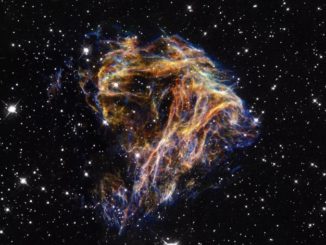
Both of these types of objects may be found away from the centre of a galaxy following a collision and merger with another galaxy containing a massive black hole. As the stars, gas and dust from the second galaxy move through the first one, its black hole would move with it.
A new study reports the discovery of one of these “wandering” black holes toward the edge of the lenticular galaxy SDSS J141711.07+522540.8 (or, GJ1417+52 for short), which is located about 4.5 billion light-years from Earth. This object, referred to as XJ1417+52, was discovered during long observations of a special region, the so-called Extended Groth Strip, with data obtained from ESA’s XMM-Newton X-ray observatory and NASA’s Chandra X-ray Observatory between 2000 and 2002. Its extreme brightness makes it likely that it is a black hole with a mass estimated to be about 100,000 times that of the Sun, assuming that the radiation force on surrounding matter equals the gravitational force.
The main panel of this graphic has a wide-field, optical light image from the NASA/ESA Hubble Space Telescope. The black hole and its host galaxy are located within the box in the upper left. The inset on the left contains Hubble’s close-up view of GJ1417+52. Within this inset, the circle shows a point-like source on the northern outskirts of the galaxy that may be associated with XJ1417+52.
The inset on the right is Chandra’s X-ray image of XJ1417+52 in purple, covering the same region as the Hubble close-up. This is a point source, with no evidence seen for extended X-ray emission.
The Chandra and XMM-Newton observations show the X-ray output of XJ1417+52 is so high that astronomers classify this object as a “hyper-luminous X-ray source” (HLX). These are objects that are 10,000 to 100,000 times more luminous in X-rays than stellar black holes, and 10 to 100 times more powerful than ultraluminous X-ray sources, or ULXs.
At its peak, XJ1417+52 is about ten times more luminous than the brightest X-ray source ever seen for a wandering black hole. It is also about 10 times more distant than the previous record holder for a wandering black hole.
The bright X-ray emission from this type of black hole comes from material falling toward it. The X-rays from XJ1417+52 reached peak brightness in X-rays between 2000 and 2002. The source was not detected in later Chandra and XMM observations obtained in 2005, 2014 and 2015. Overall, the X-ray brightness of the source has declined by at least a factor of 14 between 2000 and 2015.
The authors theorise that the X-ray outburst seen in 2000 and 2002 occurred when a star passed too close to the black hole and was torn apart by tidal forces. Some of the gaseous debris would have been heated and become bright in X-rays as it fell towards the black hole, causing the spike in emission.
The location and brightness of the optical source in the Hubble image that may be associated with XJ1417+52 suggest that the black hole could have originally belonged to a small galaxy that plowed into the larger GJ1417+52 galaxy, stripping away most of the galaxy’s stars but leaving behind the black hole and its surrounding stars at the centre of the small galaxy. If this idea is correct, the surrounding stars are what is seen in the Hubble image.



